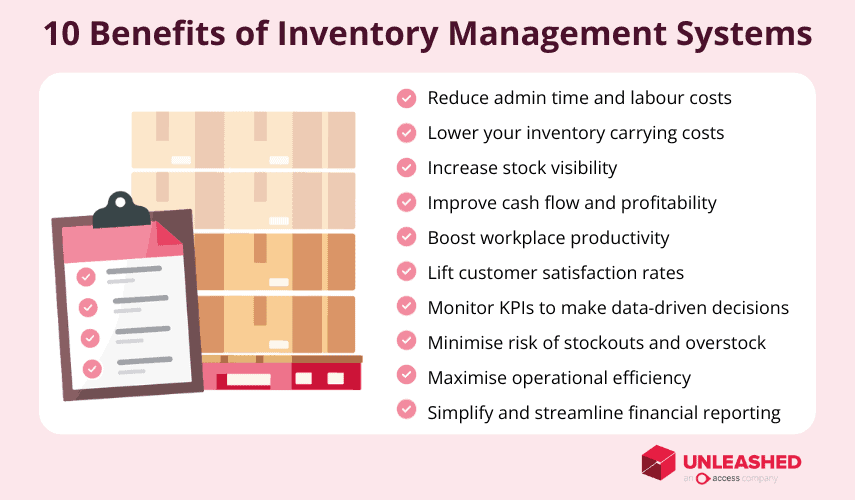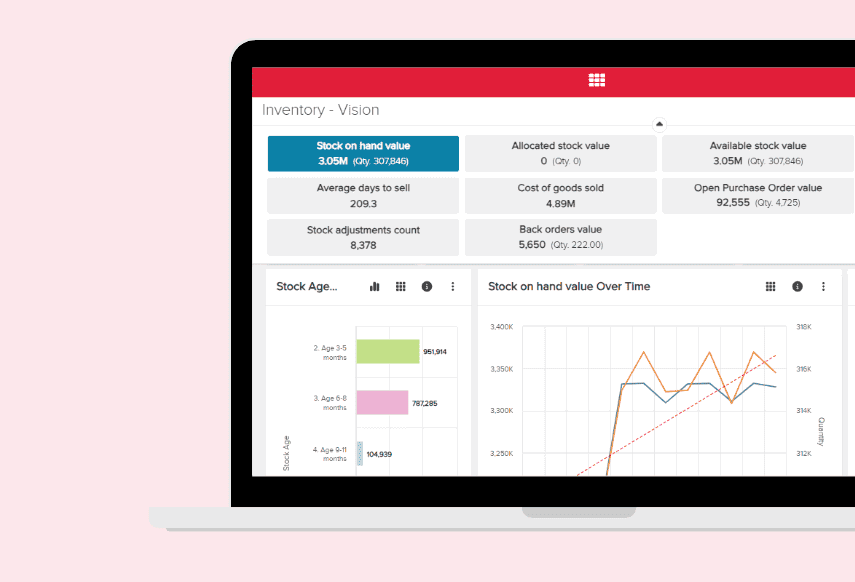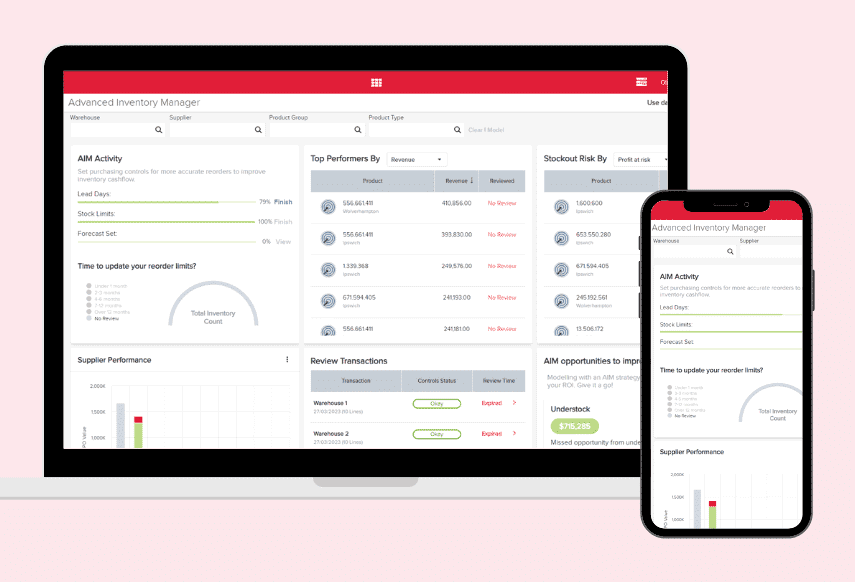
Inventory management software controls the flow of goods in and out of the company. It collects the data necessary to make the right decisions for your business, including when to order stock and in what quantities.
The benefits of inventory management software also include financial gains, such as improved cash flow and reduced inventory holding costs.
This article breaks down the top 10 benefits of inventory management software. Let’s get started.
What is inventory management software?
Inventory management software is a digital system that automates manual stock control processes to improve productivity and efficiency within a business. It provides an accessible hub containing all important information about the inventory items required to make and sell your products.
In modern business, inventory management software is vital for maintaining healthy customer satisfaction levels and reporting on taxes. It is relied on by companies as small as your local florist to major enterprises as large as Amazon, Nike, and Apple.
10 benefits of inventory management software
The top 10 benefits of an inventory management system:
- Reduce admin time and labour costs
- Lower inventory carrying costs
- Increase stock visibility
- Improve cash flow and profitability
- Boost productivity with automated processes
- Lift customer satisfaction rates
- Monitor KPIs and make data-driven business decisions
- Minimise risk of stockouts and overstock
- Maximise operational efficiency
- Simplify and streamline financial reporting
Let’s break down how inventory management software can help you achieve these benefits – and why they’re important advantages to gain.

1. Reduce admin time and labour costs
Inventory management software is designed to streamline processes and make your business more cost-effective. It does this by automating manual workflows – for example, purchase order management, inventory tracking, and demand forecasting – to reduce the time and labour required to operate.
Reducing your administrative work frees up more time for other revenue-generating activities, so you can increase focus on the areas that most impact success.
2. Lower inventory carrying costs
A key financial benefit of implementing an inventory management system is that it allows you to set optimal levels for every stocked item.
By collecting and analysing sales data, a modern inventory system can tell you the minimal volumes of inventory you’ll need to meet customer demand and when to reorder – and even automate that reordering process.
This will greatly reduce your inventory carrying costs and any other costs associated with the handling of inventory items.
3. Increase stock visibility
Modern inventory management software lives on the cloud, aka the Internet. The benefit of this is that your inventory data is accessible and modifiable from anywhere with an internet connection.
Because these changes are recorded in real time, all your stock levels and locations will always be up-to-date and accurate. This means you’re better positioned to make the right purchasing decisions, respond swiftly to customer enquiries, and avoid overstocking or overselling.

4. Improve cash flow and profitability
Cash flow presents one of the toughest challenges for businesses. Inventory management software helps ensure there’s always enough capital available to pay your bills, purchase inventory and equipment, and pay staff.
It also helps you accurately track your cost of goods sold and understand profitability at the business and product levels. By reducing your inventory holding costs and optimising your purchasing cycles, an efficient inventory system protects your cash flow so you can keep those business wheels turning all year long.
5. Boost productivity with automated processes
Inventory management systems are effective solutions for increasing workplace productivity.
Without automated stock control, you’ll need to walk to the storage location of each SKU and individually count them to determine your stock levels. Inventory management software gives you instant stock visibility at any time – saving you hours normally spent walking back and forth.
This is just one example of how inventory software can boost productivity.
Other manual processes that can be streamlined with automation include:
- Purchase order management
- Syncing data with your financial system
- Updating stock levels when new goods come in
- Bill of materials management
- Tracking key inventory metrics and KPIs
Each of these automations equals greater productivity for your business.
6. Lift customer satisfaction rates
The more efficiently your inventory is managed, the happier your customers will be.
Why? Because accurate stock records prevent you from making mistakes that disappoint customers – such as accidentally selling an item that’s out of stock or shipping the wrong product.
An optimised inventory management process also improves order fulfilment efficiency, resulting in shorter lead times. Put simply: when your stock is easier to find, your customers receive orders sooner. That means fewer cancellations and fewer customer complaints.
7. Monitor KPIs and make data-driven business decisions
Inventory management software is one of the best ways to monitor the performance of your business. You can track key sales and inventory data – such as seasonal trends, product popularity, and COGS – in one central location that’s always up to date.
Additionally, some inventory systems also act as a multichannel order management platform. This means they bring all your various sales channels under one roof to ensure a holistic reporting view that accurately reflects performance across the entire business.
The sales and inventory data you collect is automatically converted into easy-to-understand visual reports and provides invaluable insights that can inform savvy business decisions.
8. Minimise your risk of stockouts and overstock
Getting stock levels just right is one of the biggest challenges in inventory management.
Order too much inventory – overstock – and your carrying costs go up, as does the risk of holding dead stock. Order too little and you risk missing out on sales and disappointing your customers.
Inventory management software helps you determine optimal safety stock levels, reorder quantities, and replenishment times for every SKU.
Advanced inventory modules, such as Unleashed’s Advanced Inventory Manager, can even forecast future demand to help you prepare your shelves in advance of market trends.

9. Maximise operational efficiency
The benefits of inventory management software go beyond the warehouse to affect nearly all aspects of a company’s operations. This creates a snowball of efficiency gains across the business.
For example, greater stock visibility and accuracy make it easier for your finance team to account for inventory and file tax reports. When you can find out the location of a specific item simply by looking it up in the system, your order fulfilment and shipping processes likewise become more efficient.
10. Simplify and streamline financial reporting
An important feature of inventory management software is its integration with cloud-based accounting tools, such as Xero or QuickBooks.
Rather than manually inputting data every time something impacts your financial records – for example, making a sale, clearing out dead stock, or issuing a purchase order to a supplier – this information can be automatically delivered to your accounting system to save time and boost data accuracy.
Critical information for tax and business valuation purposes can also be accessed in seconds, without performing complex manual calculations.
What is the purpose of an inventory management system?
An inventory management system is designed to improve the efficiency of inventory processes and increase the accuracy of your recorded stock-on-hand levels. It does this by automating repetitive manual workflows; establishing a centralised database that updates inventory records in real time; and sharing data between your inventory, sales, and financial systems.
When is it time to invest in an inventory management system?
For emerging businesses with a small budget and low volumes of inventory to manage, a spreadsheet-based inventory management system may suffice until you’re ready to scale.
However, as your business grows and your needs become more complex, it will be more cost-effective and more efficient to invest in a cloud-based inventory management system.
The exact time to invest in inventory software will depend on your business goals and cash flow, but we recommend speaking to a business advisor or accountant to get a fair assessment of your inventory management system needs.
How does inventory management software work?
If you're still not sure which benefits of inventory management software can help your business, check out this short overview of how inventory systems work to decide if they're the right solution for you.
